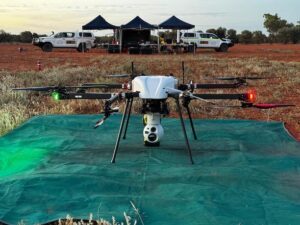
by DRONELIFE Staff Writer Ian J. McNabb
Australian drone operator Ninox Robotics recently announced a joint operation with the New South Wales Rural Fire Service to fly long-range drones for surveillance of bush and grass fires across the remote western part of the state. Using the Perimeter 8+ long range drone, capable of over 4 hours of flight time and equipped with a real-time dual electro-optical and infrared (thermal) gimballed camera, the team identified heat signatures consistent with bush and grass fires sparked by lightning strikes, a significant risk in the mostly dry conditions. The RFS used this information to both identify hot spots and to plan the distribution and management of firefighters and equipment.
Drones for Firefighting in NSW
Ninox received special permission from the Civil Aviation Safety Authority to run night flights across an 8th of the massive state (NSW is around 1.15x the size of Texas), allowing them to provide an unprecedented level of visibility during night time, when traditional fire-spotting flights are usually grounded.
The RFS echoed many of Erlich’s comments, highlighting the importance of using cutting-edge and innovative techniques (like UAV surveillance) in the firefighting space. Deputy Commissioner of the RFS Peter McKechnie said the Service was committed to protecting people and property via technology integration.
“The RFS recognises the critical importance of innovation in this field, with the aim to make a significant impact on emergency response capabilities,” Deputy Commissioner McKechnie said. “We look forward to seeing how this technology can be utilized not only to protect communities but also optimize the overall performance of our agency.”
Drones have become an increasingly important part of firefighter’s arsenals, providing unparalleled up-to-date real time information on blazes, which have grown more frequent and damaging as a result of climate change. Last year, Dronelife reported on Canadian efforts to use swarms of BVLOS drones to battle wildfires there.
More information on Ninox is available here.
Ian McNabb is a staff writer based in Boston, MA. His interests include geopolitics, emerging technologies, environmental sustainability, and Boston College sports.